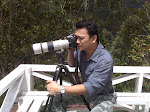Okay, don't act like you're not surprised that I'm here posting on my blog again. I kinda missed doing this, you know. I've been keeping myself quiet, quite a bit of time you know. Trying to think what I should talk about on my blog..( yeah, right you might think!)
Okay class(LOL), today I wanna talk a bit about etiquette, ethics, unwritten rules, law (or whatever you wanna call it) in bird photography. I am no expert but I'm good...not the best but better than some of the rest. The issue I would like to address today is about distance. Distance between a photographer and the subject. Which in this case are birds.
In my thousands of shutter clicks experience of birds, there's similarity to all of them regardless of species. They are a lifeforms with feelings. Yes, feelings. I do think they does have the feeling of anger, anxiety, curiosity, fear, hot, cold, etc. These feelings are for us to understand and to manipulate. So guys, mind your distance.
Let me show you how it's done...
Lesson No.1- Look at the watch.
Birds are like human, if it's hot they want to cool off too. Mountain birds are sensitive to heat. Sunny days are the time to catch them taking a dip. Pick your spot on a rocky stream and wait for the sign. This might take a while but you will get them. If you are still enough, or if you are in a hide... the composition is all yours. Be it full framed shots or even some nice habitat shot...they would not mind you being there...
Lesson No. 2- Call them!
Some birds like the Red-bearded Bee-eater is so freaking busy body. They 'laugh' like Santa Claus and if you imitate their song they'll come flying to you as if you are Snow White singing in the rainforest. You don't have to use hides or playback for this kinda bird. They are curious and daring enough to get close to you.
Lesson No.3- Get busy & lucky!
Don't just sit there reading about reviews, news feed, worrying about your gears what you don't and what you do have. Get out and shoot man!What the heck are you thinking! Birds won't go and knock your door for you to photograph them. Some rare species only live in certain habitat, so use your knowledge to a good use. Pack your stuff, get busy an find your luck.
Once you're there, repeat steps 1, 2, 3! Even if your there doesn't mean they are there...look closer & find them!
Well, It's as easy as 123 Isn't it? Is there any rules or etiquette broken in doing the 123??? I don't think so...Okay, I'm done for now. Hope all of you enjoyed my class... until then, see you. Don't forget the 123 rules!
P/s...All pictures above were taken using Canon EOS40D & more or less posted at the original form.







